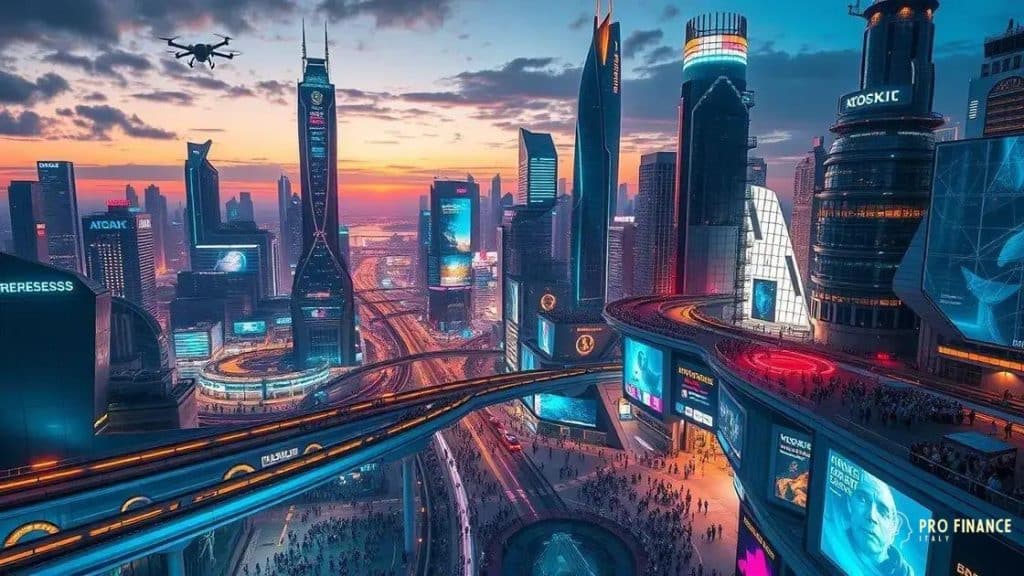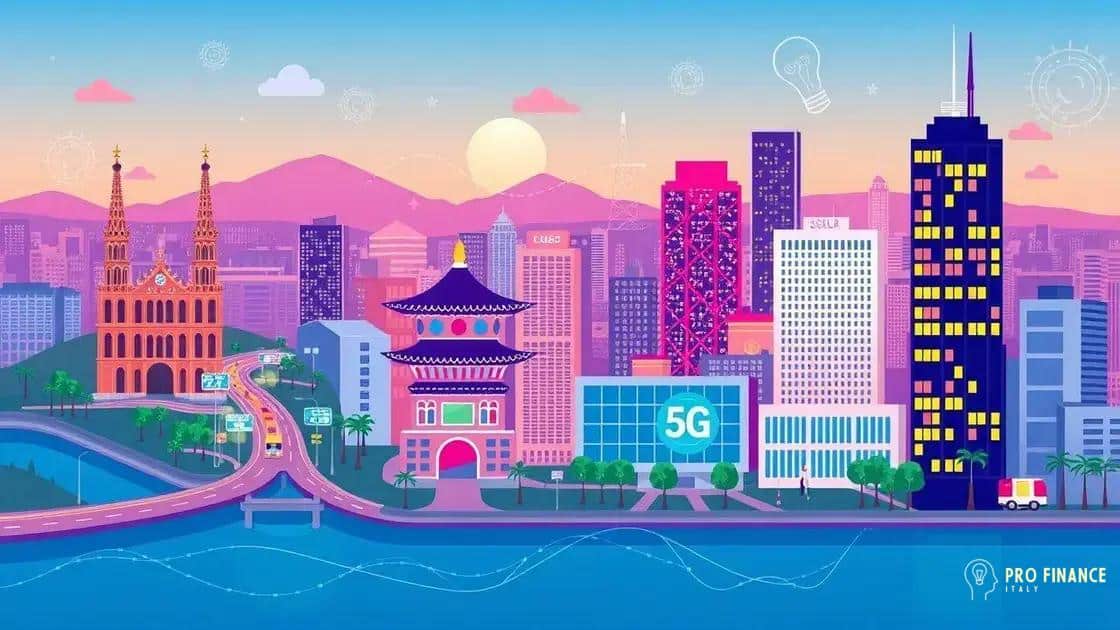How 5G technology is enabling smarter cities

5G technology is transforming cities into smarter urban environments by enhancing public safety, improving transportation systems, and enabling sustainable practices through real-time data and connectivity.
How 5G technology is enabling smarter cities is opening up exciting possibilities for urban environments. Have you ever thought about the impact of faster connectivity on your daily life? Let’s explore how this technology is transforming cities.
Understanding 5G technology and its components
Understanding 5G technology is vital for grasping how it can enhance our urban environments. With its rapid data transfer speeds and low latency, 5G is the foundation for building smarter cities.
The primary components of 5G technology include small cells, millimeter waves, and massive MIMO (Multiple Input Multiple Output). These elements work together to create a robust network. Each component plays a crucial role in ensuring reliable connectivity and efficient data delivery.
Key Components of 5G Technology
- Small Cells: Small cells are low-powered cellular nodes that cover short distances. They help expand network capacity and improve overall performance.
- Millimeter Waves: These high-frequency waves allow 5G to transmit large amounts of data quickly. They are essential for supporting the demands of modern applications.
- Massive MIMO: This technology uses multiple antennas at base stations to improve the capacity and efficiency of the network. It enhances signal strength and reduces interference.
As cities grow, the demands on technology increase. 5G technology rises to meet these demands, providing faster communication for smart traffic systems and real-time public safety features. The shift from 4G to 5G is more than just speed; it’s about enabling new services that benefit all city residents.
Incorporating 5G technology into urban planning can lead to significant improvements. For instance, real-time data collection can support better transportation systems and reduce congestion. As more cities adopt this technology, we will see innovative applications tailored to local needs.
The role of 5G in urban infrastructure improvement

The role of 5G in urban infrastructure improvement is transformative. With 5G, cities can modernize their infrastructure to meet the needs of a growing population. This technology enables better connectivity between various systems, making urban living more efficient.
5G improves key urban services such as transportation, waste management, and energy distribution. By connecting devices and systems, cities can operate smoothly and respond to needs in real time.
Enhancing Transportation
One of the most significant impacts of 5G is on transportation. With improved data transfer rates, cities can implement smart traffic management solutions. These solutions analyze traffic patterns and adjust signals to reduce congestion, ensuring smoother traffic flow.
- Real-Time Monitoring: 5G allows for real-time tracking of vehicles and public transport, providing accurate arrival times and helping commuters plan better.
- Connected Vehicles: Autonomous cars can communicate with traffic systems, providing safer and more efficient travel.
- Emergency Response: In emergencies, 5G facilitates quicker communication between emergency services, ensuring faster response times.
The benefits extend beyond transportation. 5G technology helps cities manage resources more effectively. For example, with smart sensors in waste bins, cities can optimize collection routes, reducing costs and emissions.
Energy management is another area where 5G shines. Smart grids can monitor energy use and adjust distribution quickly. This ensures efficiency and enhances sustainability, which is crucial for modern cities striving to reduce their carbon footprints.
Enhancing public safety through 5G connectivity
Enhancing public safety through 5G connectivity represents a major advancement for urban areas. With the power of 5G, cities can implement enhanced safety measures that protect citizens and improve emergency response.
5G technology equips first responders with tools that can save lives. For instance, faster data transfer speeds allow emergency services to receive information in real time. This means that when an incident occurs, responders have immediate access to critical details.
Real-Time Surveillance
One significant application of 5G in public safety is real-time surveillance. High-definition cameras connected through a 5G network can analyze situations and help law enforcement respond quickly. This technology can also recognize patterns and alert officers to suspicious activities.
- Crime Prediction: Advanced analytics can help predict crime hot spots, allowing police to allocate resources effectively.
- Disaster Management: In case of natural disasters, 5G enables better communication among emergency teams, improving coordination and rescue efforts.
- Smart Sensors: Sensors placed in public areas can monitor environmental hazards and detect emergencies, providing instant alerts to authorities.
As cities grow in population, ensuring public safety becomes increasingly challenging. 5G technology enhances communication among various public safety agencies. For example, police, fire departments, and medical services can share information seamlessly, leading to quicker responses.
Furthermore, citizen engagement improves with 5G. Apps that allow residents to report incidents or suspicious activities provide an extra layer of safety. This two-way communication streamlines the interaction between the public and safety agencies.
Case studies of cities leveraging 5G technology

Case studies of cities leveraging 5G technology provide valuable insights into how urban areas can improve the quality of life for their residents. Several cities around the world have adopted 5G to enhance services, boost efficiency, and create safer environments.
One notable example is Barcelona, which has implemented 5G in its smart city projects. The city uses this technology to manage traffic more effectively, monitor waste collection, and improve public safety. With real-time data, Barcelona is focused on reducing congestion and ensuring timely responses to incidents.
Another example is Seoul
Seoul has integrated 5G technology to foster innovation and improve city services. The city’s advanced network supports numerous applications, including smart transportation systems that provide updates about public transit in real-time. This interconnectedness allows for better urban mobility and improved commuter experiences.
- Health Sector: Telemedicine services have grown significantly due to 5G, enabling doctors to consult with patients remotely.
- Smart Cleaning: Waste management systems employ sensors to optimize collection routes, thus saving time and resources.
- Infrastructure Monitoring: Real-time data from sensors in bridges and roads help prevent accidents and enhance maintenance.
In the U.S., Los Angeles is also leading by example. The city has partnered with telecommunications companies to implement 5G in various applications, including enhancing emergency response services and developing smart traffic lights. These innovations not only improve safety but also boost overall efficiency in city operations.
Moreover, Chicago is using 5G for smart city initiatives. With enhanced connectivity, the city has been able to deploy sensors for monitoring air quality and traffic patterns. This valuable data helps make informed decisions about urban planning and public health initiatives.
Future trends in smart city developments
Future trends in smart city developments are exciting and full of potential. As technology evolves, cities are looking to enhance the quality of life for their residents using innovative solutions. One of the main trends is the integration of artificial intelligence into urban management systems.
AI can analyze vast amounts of data to optimize city services. For instance, traffic systems can adapt in real time based on current conditions. This means faster travel times and reduced congestion for everyone.
Smart Public Transport
Another key trend is the development of smart public transport systems. With 5G connectivity, buses and trains can communicate with each other and with waiting passengers. Users can receive updates about arrival times and available seats. This technology greatly enhances the commuting experience.
- Real-Time Tracking: Passengers can track their transportation in real-time, ensuring they never miss their bus or train.
- Dynamic Routing: Public transport can adjust routes based on demand, improving service efficiency.
- Electric Vehicles: Many cities are moving towards electric public transport to reduce emissions and promote sustainability.
In addition to transport, cities are also focusing on sustainable practices. Green buildings equipped with smart technologies help manage energy consumption efficiently. Solar panels and smart lighting reduce costs and environmental impact.
Health technology is another growing field in smart cities. With telehealth services and health monitoring devices, residents can access medical care easily. These advancements ensure that healthcare makes significant leaps, especially in urban areas with dense populations.
Furthermore, citizen engagement plays a big role in shaping smart cities. Tech-savvy platforms allow residents to voice their opinions and participate in decision-making processes. This democratic approach ensures that urban plans reflect the needs and desires of the community.
In summary, 5G technology is paving the way for smarter cities. With benefits like enhanced public safety, smarter transportation systems, and better citizen engagement, it’s clear that the future of urban living is bright. By leveraging AI and sustainable practices, cities can create environments that improve the quality of life for all residents. As more cities embrace these innovations, we can anticipate a significant shift in how we experience urban life, making our cities safer, more efficient, and more connected.
FAQ – Frequently Asked Questions about 5G Technology in Smart Cities
How does 5G improve public safety?
5G enhances public safety by providing real-time data to emergency responders, allowing for faster and more efficient responses to incidents.
What benefits does 5G offer for public transportation?
5G allows for real-time tracking of public transport, dynamic routing, and better communication, improving the overall commuting experience.
How can cities use 5G to become more sustainable?
Cities can use 5G for smart grids and energy management systems that monitor consumption and reduce waste, contributing to sustainability goals.
Can citizens engage more with their local government through 5G?
Yes, 5G enables technology platforms that allow citizens to express their opinions and participate in decision-making processes, enhancing community engagement.





